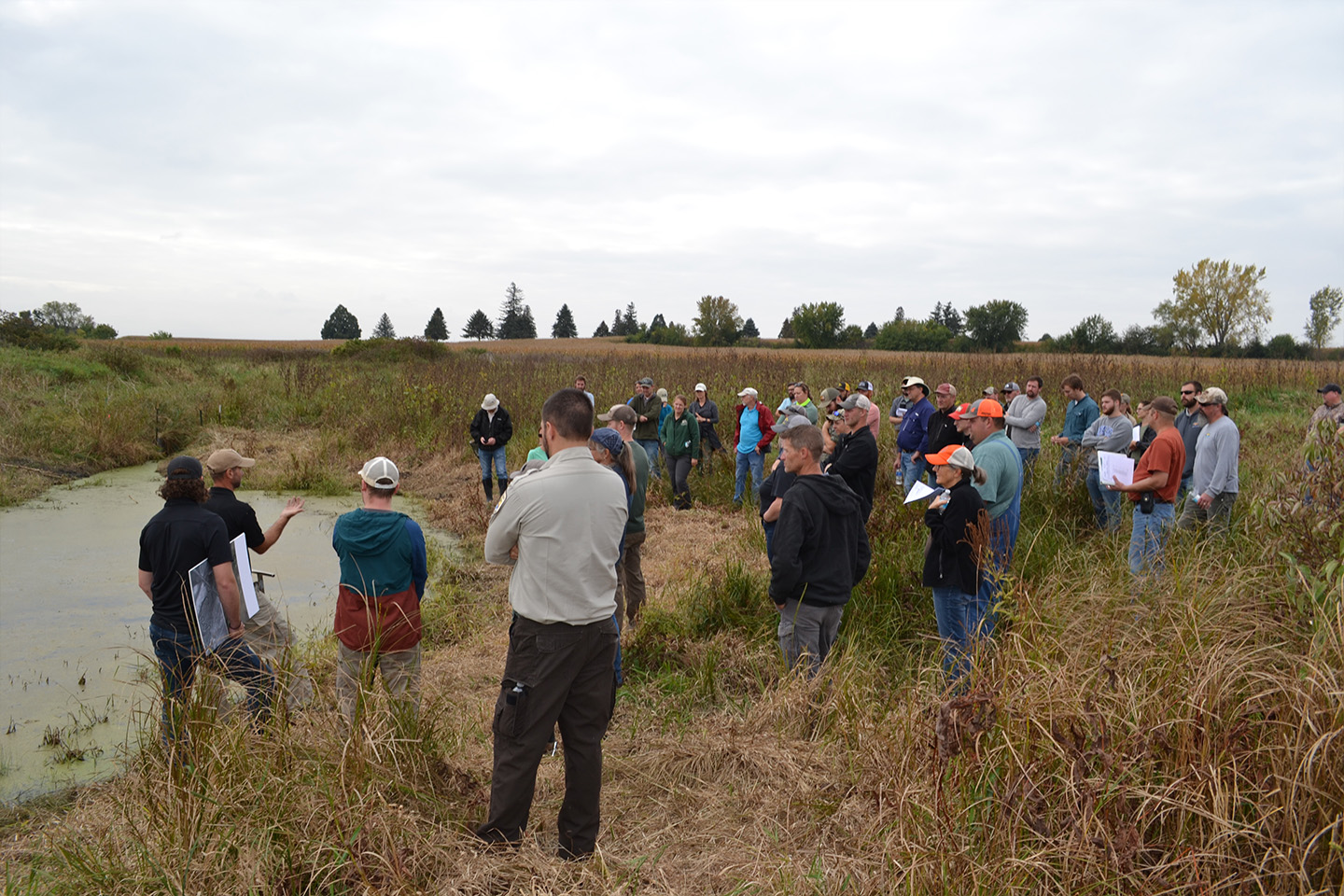
Conservation professionals explore a restored oxbow recently during an oxbow restoration training held near Lu Verne. (Photo: Kriss Nelson, Iowa Soybean Association)
Oxbow restoration training
October 21, 2021 | Kriss Nelson
There are several opportunities to add oxbows to Iowa’s landscape, but the first step is learning how to do so.
The Iowa Soybean Association, along with the U.S. Fish & Wildlife Service, Natural Resources Conservation, The Iowa Department of Agriculture and Land Stewardship and The Nature Conservancy recently joined forces on an oxbow restoration training.
The two-day training, which was geared toward conservation professionals, included a virtual and an in-person event.
The purpose of the training was to help educate conservation experts about oxbow restoration and to further dive into the details of the recently developed Oxbow Toolkit. The Oxbow Toolkit is a step-by-step guide for restoring oxbow wetlands. It’s available at no cost, and can be downloaded through this site.
“It was very successful,” said Darrick Weissenfluh, fish and wildlife biologist with the U.S. Fish and Wildlife Service, who was one of the presenters. “The questions and engagement we had were exceptional.”
The day one virtual training video reached 82 participants from across Iowa.
The in-person training allowed for 42 conservation professionals, representing 17 different organizations/counties.
“People from across the state embarked to the training, it was a great time of year to get together with conservation folks to walk through how to restore these oxbows,” said Brandon Iddings, Iowa Soybean Association field services program manager for conservation resources.
What's an oxbow?
Oxbows — the winding, meandering, disconnected pools — are a common sight across the Iowa landscape. Over time, the calmer waterways become filled with sediment carried in from the mainstream. Restoring oxbows can offer a wide range of benefits, from the ecological such as providing an ecosystem for endangered wildlife; to the preventative, as oxbows can help remove nitrates before heading for a waterway.
“The idea was to help scale up the adoption of oxbow restoration and to help conservation professionals feel comfortable and confident in doing restorations on their own so we can get this practice to scale in order to see some measurable changes across the landscape,” says Karen Wilke, Iowa Freshwater Specialist and Boone River Project Director for The Nature Conservancy, presenter and one of the organizers of the event.
Weissenfluh is optimistic oxbow restorations will continue to be implemented around the Iowa landscape. One reason is because fish, including the state- and federally listed Topeka shiner, relies on oxbow habitat.
“We wanted to make sure that as folks are doing these restorations, they are aware of those impacts and the opportunities that exist for restorations as well as some of the design considerations that will need to be a part of those restorations,” he says.
Iddings says oxbow restorations provide benefits to farmers, too.
“At the Iowa Soybean Association, we work for the farmer,” Iddings says. “I always try to bring the farmer aspect into the oxbows, and I tried to bring that into these trainings. Oxbows are good for water quality; they are a good edge-of-field practice.”
Attendees were taught the mapping aspects of the location and design stages. They also learned how to gain the proper permits and how to start the conversation with landowners about the benefits of oxbows, which include wildlife habitat, land beautification, flood storage and improved water quality.
“We are trying to be innovative – just like farmers and get the best practices out there for the most efficient cost and what is most beneficial to the landowner,” Iddings says.
Mary Beth Stevenson, watersheds and source water program manager for the city of Cedar Rapids attended both the virtual and in-person training sessions.
“I gained a really good understanding of the overview of the process – from start to finish and the steps it takes,” she says. “It was great to get acquainted with the resources available for oxbow restorations – that was really helpful. The tool kit is going to be a great resource for me.”
Weissenfluh is looking forward to additional in-person trainings with other conservation professionals who were unable to attend.
“We welcome those folks to reach out and let us know they would like to participate in a future training. If we can focus those on certain watersheds, we would love to do so,” he said.
Iddings invites farmers and landowners to future fields days, including the Nov. 10 Iowa Learning Farms Field day near Lu Verne: https://www.iowafarmbureau.com/Article/New-conservation-field-days-announced-for-week-of-November-8
“I think farmers have a unique perspective. I would like to get them out to the sites and answer questions,” Iddings says.
The trainings were funded through a grant awarded to The Nature Conservancy through the Iowa DNR’s Conservation Education Program.
If you’re interested in learning more about oxbow restorations in Iowa and a landowners perspective, you can view a presentation here (about the 70 minute mark): https://drive.google.com/file/d/1lbxNkfIoI-k3pF95dEk10c36JnN1XNQn/view
Find the day one virtual training here. The passcode is PX*5?!3f.
For additional information on potential funding for oxbow installations in targeted watersheds, please contact Brandon Iddings at biddings@iasoybeans.com or 515 729 0039.
Joseph Hopper contributed to this story.
Back